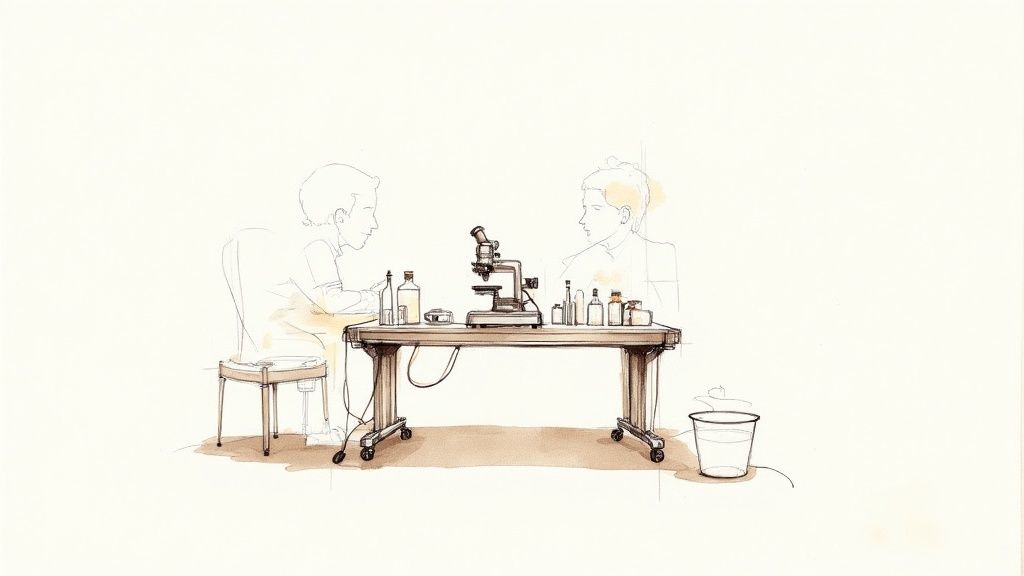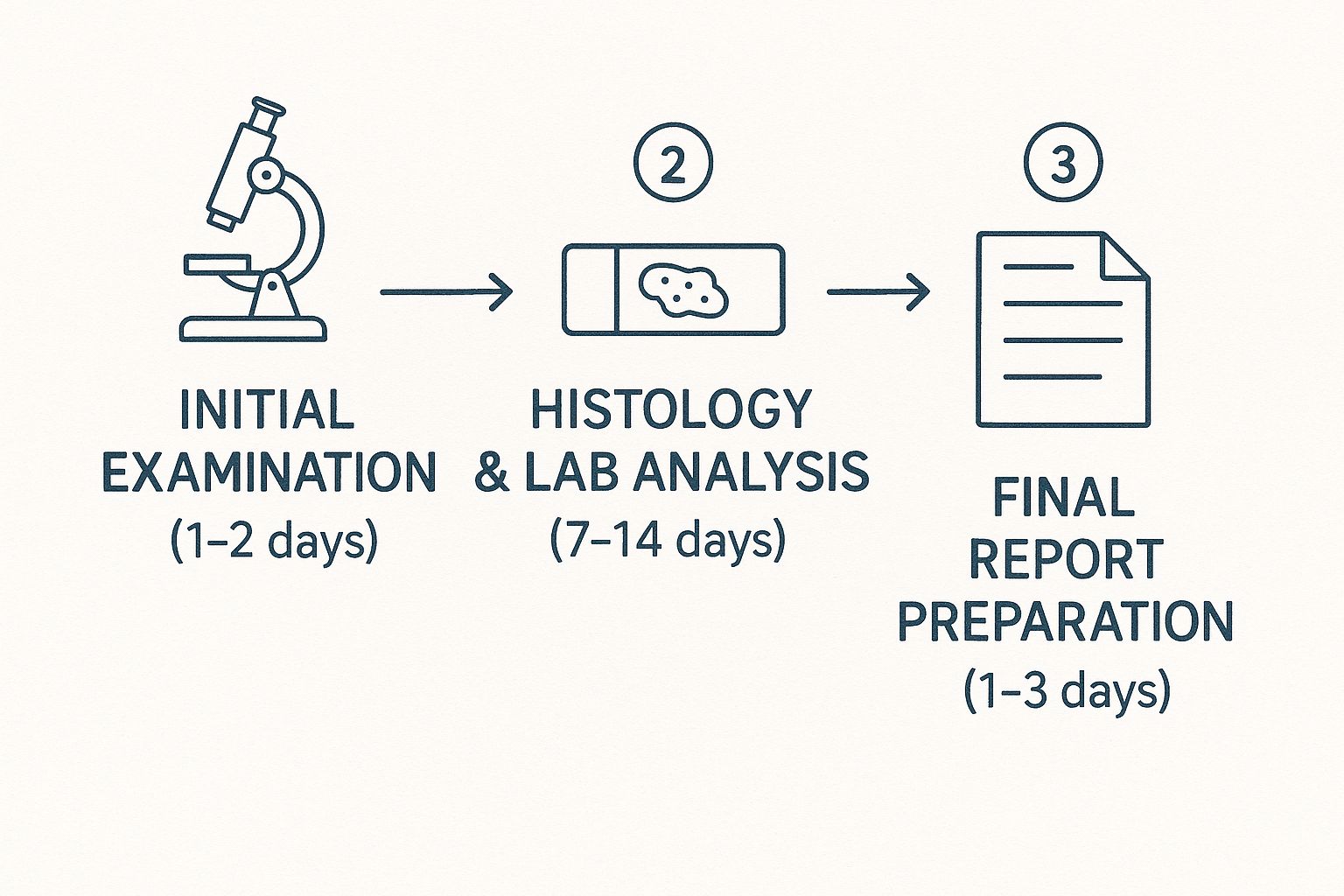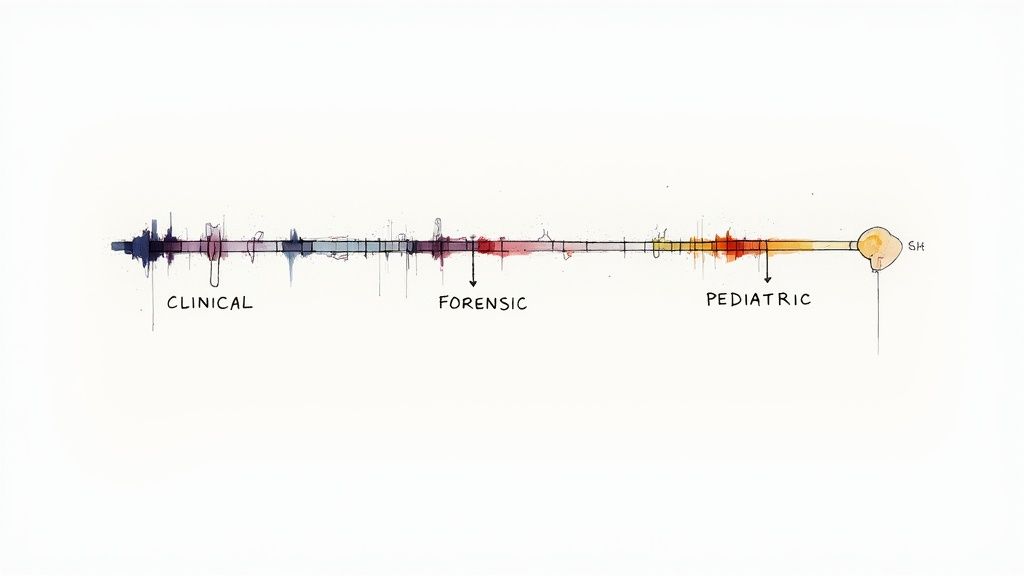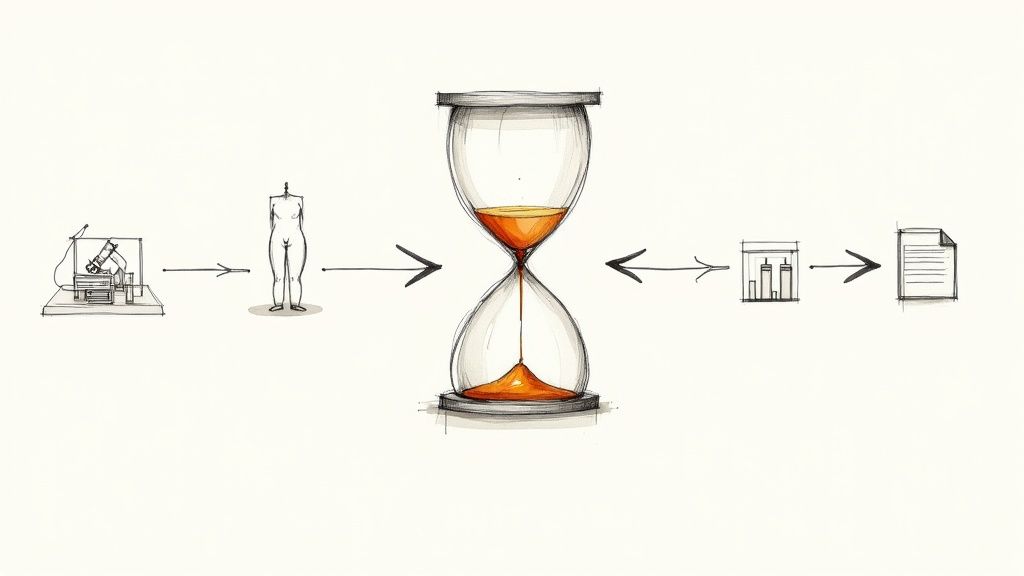When a loved one passes, the wait for answers can be one of the most difficult parts of an already painful experience. As a forensic pathologist, I am often asked, "How long until we get the autopsy results?" It is a completely understandable question born from a need for closure.
While preliminary observations from the physical examination may be available within a day or two, a complete, final report is a much more involved process. You should generally anticipate a timeframe of 6 to 8 weeks, though this can extend further for more complex cases. This timeline is not due to a lack of urgency but is a necessary function of a meticulous, multi-stage scientific process that cannot be rushed if the truth is to be found.
The Difficult Wait for Answers
I understand that waiting for an autopsy report is an emotionally draining experience. In a time of grief and uncertainty, the last thing anyone wants is a prolonged period without clear answers. However, every step in this process, from the initial external examination to the final signature on the report, must meet exceptionally high standards of medical accuracy and legal integrity.
My purpose here is to provide a clear view of what happens during this waiting period. Understanding the "why" behind the wait can help set realistic expectations and, I hope, offer a small sense of clarity when so much feels uncertain.
Key Stages in the Autopsy Timeline
The autopsy is not a single event but a sequence of distinct phases, each contributing to the final conclusion.
- Initial Examination: This is the physical component of the autopsy, encompassing external and internal assessments. It is typically completed within 24 to 48 hours of receiving the decedent.
- Ancillary Studies: This is almost always the most time-consuming phase. It involves sending tissue and fluid samples to specialized laboratories for tests like toxicology (detecting drugs or poisons), histology (examining tissues microscopically), and microbiology. These critical analyses can take several weeks to complete.
- Report Compilation: Once all laboratory data is returned, I synthesize the findings from every source. This involves correlating the physical evidence with the microscopic and chemical data to form a comprehensive narrative and determine the cause of death.
- Final Review and Signing: Before release, the completed report undergoes a final quality assurance review, often by a peer, to ensure accuracy and completeness. It is then signed and becomes an official document.
The wait is challenging, but this scientific rigor ensures the answers provided are the correct ones—the definitive answers your family deserves.
Autopsy Results Timeline At a Glance
For a clearer perspective, this table outlines the typical timeframes for each major stage of the process.
| Autopsy Stage | Typical Timeframe |
|---|---|
| Initial Examination | 1–3 Days |
| Ancillary Testing (Toxicology, etc.) | 2–6 Weeks |
| Data Integration & Report Writing | 1–2 Weeks |
| Final Review & Release | 2–4 Days |
Please remember, this is a general guide. Every case is unique, and timelines can shift based on the specific circumstances and complexity of the investigation.

Breaking Down the Autopsy Process Step by Step
To truly understand the timeline for autopsy results, it is helpful to view the procedure not as one event but as a series of deliberate, evidence-based steps. Much like solving a complex puzzle, each piece must be examined individually before its place in the larger picture can be understood.
This methodical journey from initial examination to final report is designed to ensure every conclusion rests upon a solid foundation of scientific evidence.
The Initial Physical Examination
The first phase is the hands-on portion of the autopsy, which usually occurs within 24 to 48 hours to ensure the integrity of the tissues. It is divided into two key parts:
- External Examination: My process always begins with a thorough documentation of the body’s exterior. This includes recording height, weight, and any identifying features like scars or tattoos. I meticulously note any signs of injury or evidence of medical intervention. No detail is too small to be recorded.
- Internal Examination: Following the external exam, I conduct a respectful and systematic internal examination of the major organ systems. Each organ is carefully weighed, measured, and inspected for any visible signs of disease, trauma, or other abnormalities. This stage provides the initial roadmap for which areas require deeper laboratory investigation.
While this first stage provides immediate clues, the full story often unfolds during the subsequent laboratory analyses.
Ancillary Studies and Laboratory Analysis
This is where the clock truly starts, and it is almost invariably the longest part of the process. After the physical examination, small samples of tissues and fluids are sent for specialized testing. These ancillary studies are essential for discovering answers that are invisible to the naked eye.
The answers we seek are frequently found at the microscopic and chemical levels. Rushing these intricate scientific procedures would risk an inaccurate or incomplete conclusion, an outcome we must avoid at all costs.
Some of the most common and crucial tests we run include:
- Toxicology: A comprehensive screening to detect and quantify the presence of drugs, alcohol, prescription medications, poisons, or other chemical substances.
- Histology: Extremely thin slices of organ tissue are prepared, placed on glass slides, and examined under a microscope. This is how I can identify diseases like cancer, infection, or chronic inflammation at a cellular level.
- Microbiology: If an infectious disease is suspected, cultures are taken to grow and identify the specific bacteria, virus, or fungus responsible for the illness.
This image illustrates how these different stages fit together to form the complete timeline.

As you can see, the hands-on examination is relatively brief. The detailed, behind-the-scenes laboratory work consumes the most time, often stretching for several weeks. Each step is non-negotiable for constructing an accurate and complete picture of events.
If you are interested in a more detailed overview, you can learn more about what a forensic autopsy entails in our detailed guide.
Why Some Autopsy Results Take Longer
Not every investigation follows a linear path. Several key factors can extend the timeline for a final autopsy report, and it is important for families to be aware of these possibilities. I often compare my work to assembling a complex puzzle; some are straightforward, while others resemble a 5,000-piece set with no reference picture.
For example, a case involving extensive trauma, suspected poisoning, or a potential infectious disease requires a much deeper investigation with specialized testing. This contrasts with a sudden death from natural causes in an individual with a well-documented medical history. The latter may yield clear answers from the initial examination, but the former demands patience and absolute precision.

Factors That Influence the Timeline
A few common variables can add weeks, or even months, to the process. It is important to understand that these are not signs of inaction but indicators of a thorough and responsible investigation.
- Case Complexity: As mentioned, toxicology is a significant factor. Identifying and quantifying a specific drug or toxin is meticulous, time-consuming laboratory work. We have a detailed article explaining exactly what a toxicology report after death involves.
- Administrative Delays: Sometimes, the hold-up is purely logistical. We may be waiting for medical records from a hospital, a final report from law enforcement, or navigating the high caseload of a busy medical examiner’s office.
- Need for Outside Specialists: In certain cases, I must consult other experts. I might send brain tissue to a neuropathologist to investigate for subtle signs of disease or engage a forensic odontologist for dental identification.
The Role of Specialized Testing
The time required for results has always been dependent on the case specifics and available resources. While the physical autopsy is almost always completed within 24 hours to preserve tissue quality, it is the subsequent analysis that truly dictates the schedule.
This is particularly true for histology—the microscopic examination of tissues. Preparing tissue slides, applying specialized stains, and having a pathologist interpret them can easily take weeks. It is a delicate, multi-step process that cannot be accelerated.
A longer wait does not mean nothing is happening. It often reflects the complexity of the case and an unwavering commitment to delivering a definitive, accurate, and legally defensible conclusion.
Ultimately, every step is taken to ensure the final report is built on a foundation of certainty.
How to Stay Informed While You Wait
Waiting for answers can feel isolating, but it is important to remember that communication channels are available. Maintaining clear lines of contact can make a significant difference and help ease some of the uncertainty. Knowing who to call and what to ask is key.
Your primary point of contact is typically the pathologist's office or the medical examiner/coroner handling the case. If you have commissioned a private autopsy, like the services we provide, you will have a direct and consistent line of communication. For a medicolegal case, you may be speaking with an assigned investigator or an administrator.
Clarifying What to Expect
It is helpful to understand the distinction between preliminary findings and the final report. Think of preliminary findings as the pathologist's initial observations from the physical examination. They are often available relatively quickly but are, by definition, preliminary. They do not represent the complete picture and are subject to change.
These initial thoughts may be shared with law enforcement to aid their investigation or with a funeral director to facilitate arrangements. They are never the final word.
The final, comprehensive report is the official legal document. It integrates all findings—the physical exam, toxicology, histology, and any other tests—to provide a conclusive, legally sound determination of the cause and manner of death.
When you reach out for information, having a few specific questions prepared can help guide the conversation:
- "Could you please confirm who my primary point of contact will be for updates?"
- "Is there a general estimate for when the final report might be ready?"
- "Once the report is complete, how will it be delivered to our family?"
Our goal is to ensure you feel supported and informed, not left in the dark during such a challenging time. While the science must run its course, open communication can make the wait more manageable.
Understanding the Final Autopsy Report

After weeks of careful analysis, the final autopsy report is completed. This document synthesizes every piece of the investigation to provide definitive, evidence-based answers. I know from experience that these reports can feel overwhelming. They are dense, clinical, and filled with medical terminology that can be difficult to navigate, especially during an emotional time.
My goal here is to help you make sense of this vital document. Consider the final report as the complete narrative of the investigation, with each section serving as a different chapter, weaving all evidence into a cohesive story that leads to a clear conclusion.
Key Components of the Report
While the exact layout may vary, most final autopsy reports share a common structure. Each part builds on the last to create a comprehensive picture of the findings.
- Circumstances of Death: A brief summary of the information known at the time of death, often drawn from family, medical records, or law enforcement reports.
- External and Internal Findings: This section details every observation from the physical examination, covering everything from identifying marks and scars to the precise condition of each internal organ.
- Microscopic Descriptions: This is where we delve into the cellular level. This section records the histology results, explaining what the tissues revealed under the microscope.
- Ancillary Studies: This part consolidates the final results from toxicology, microbiology, and any other specialized tests that were performed.
The most crucial section is the Final Anatomic Diagnosis. This is the definitive conclusion—a clear, concise summary of all significant findings that officially states the cause and manner of death.
This final diagnosis is not an opinion. It is a medical conclusion supported by every piece of data gathered throughout the entire process. It is the answer we have been working diligently to provide.
To get a better sense of how these components come together, you can view a sample document showing a typical pathology report format. Seeing the structure firsthand can provide the clarity needed to understand this important document.
Frequently Asked Questions About Autopsy Timelines
Losing someone leaves you with many questions. As a forensic pathologist, I have found that providing clear, direct answers about the autopsy process can bring a small measure of comfort during a very difficult time. Here are a few of the questions I hear most often regarding timelines and expectations.
Who Receives the Final Autopsy Report?
The final report is a sensitive legal document, and its distribution is tightly controlled.
If you have commissioned a private autopsy, the report is provided exclusively to the individual who legally authorized it—typically the next of kin or a designated legal representative.
For a medicolegal case managed by a medical examiner or coroner, the report is technically a public record. However, access may be restricted until any related law enforcement investigations are concluded.
Can I Get Updates Before the Final Report?
This is a common and understandable question. While you must wait for the final, comprehensive report, it is sometimes possible to receive preliminary findings.
These initial observations are based solely on the physical examination. They are always subject to change once all laboratory tests are finalized. It is best to ask your primary contact directly about their policy on providing interim updates.
Why Can’t I See the Report Sooner?
The simple answer is that good science takes time. The timeline is not about bureaucracy; it is about precision and accuracy.
Every test—whether for toxicology, histology, or microbiology—follows a strict, validated protocol. Rushing these steps could easily lead to erroneous results. My most important responsibility is to deliver a conclusion that is scientifically sound and can withstand legal scrutiny.
It's a common misconception that a long wait means something is wrong. In reality, a longer timeline usually points to a more complex case—one that requires a deeper investigation to provide the family with the definitive answers they deserve.
This meticulous work is more important than ever. In the 1960s, autopsies were performed in up to 41% of hospital deaths in the U.S. By the mid-1990s, that figure had fallen to between 5% and 10%. You can learn more about this trend from the CDC's detailed analysis. With fewer autopsies being performed, the diagnostic and legal weight of each one has grown, reinforcing the need for uncompromising thoroughness.
If you have more questions or need to arrange for a private autopsy, our team at Texas Autopsy Services is here to assist with compassion and precision. Please do not hesitate to call our office to discuss your needs.

